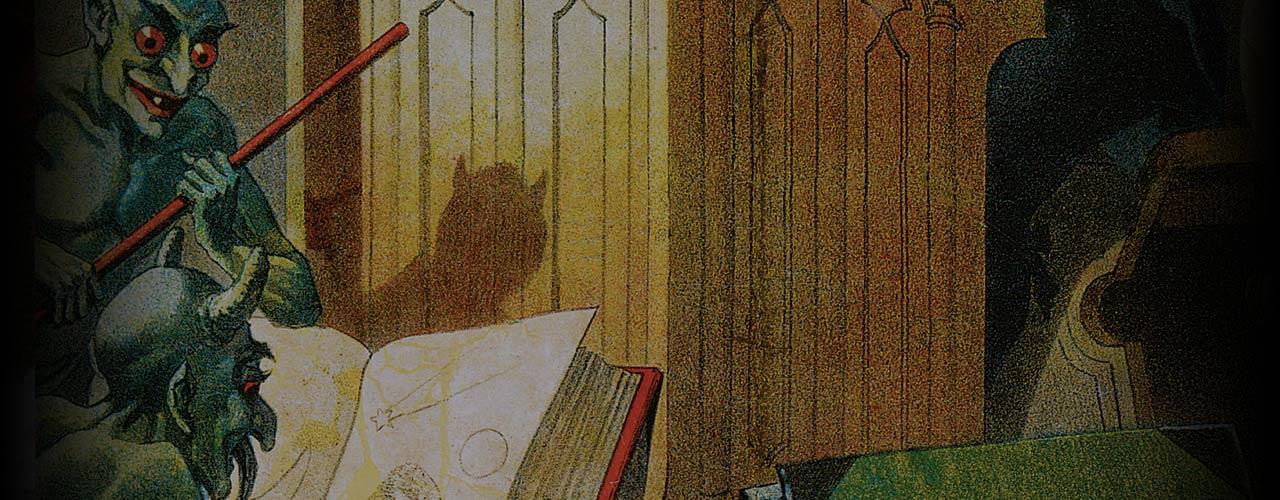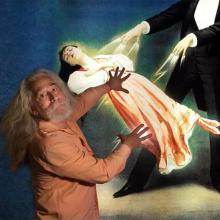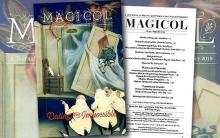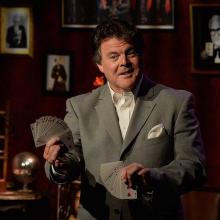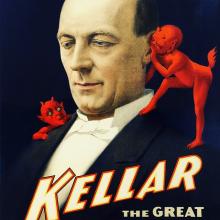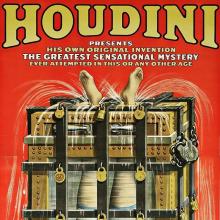Submitted by Jamy Ian Swiss on

The Top Change: Monarch of Card Sleights
By Magic Christian
Book Review by Jamy Ian Swiss
I love unlikely magic books. In 1946, Jean Hugard and Frederick Braue wrote The Invisible Pass, a large format hardcover book featuring an abundance of large-scale photographs illustrating a single sleight over the course of 29 pages. It’s a fabulous conception, likely the first book ever devoted entirely to a single sleight; and a lovely volume I still enjoy pursuing from time to time.
Now Magic Christian outdoes Hugard and Braue with 173-hardbound pages devoted to the Top Change. The author declares, “This volume is the first book dedicated entirely to a study of the Top Change, its variants and their proper execution.” If this seems an unlikely mission, certainly the Austrian magician, historian and author Christian Stelzel—better known to magicians as Magic Christian—is a supremely qualified candidate for attempting such a task. Undoubtedly the foremost authority on the Austrian conjuring maestro Johann Nepomuk Hofzinser, whose nineteenth century inventiveness continues to influence present day card magic, Christian is the author of the definitive “trilogy in four volumes” on Hofzinser, which includes a 1998 book of biographical research, a 2004 book of Hofzinser’s card magic, and the massive, and beautiful, 2004 two-volume set, Non Plus Ultra, produced in German and English editions.
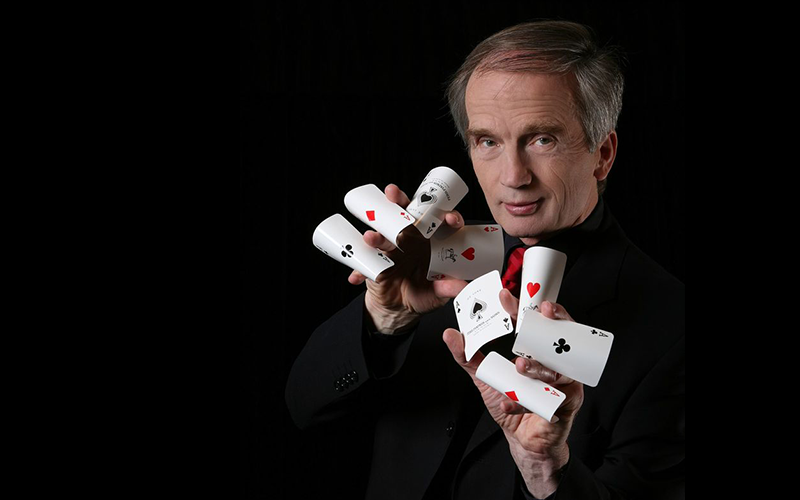
What’s more, and particularly relevant to the new book at hand, is that Magic Christian is also an accomplished performing magician who took first prize in manipulation at FISM, no less than three times—in 1973, 1976 and 1979. And, in 1979, in addition to his recognition for manipulative magic, he also competed in close-up magic, and was awarded the FISM prize for invention for his clever “Magic Chain” routine. This unusual effect used large links of chain to perform a version of “coins through the table” where the links not only penetrated the table but also magically, and progressively, linked in order to create a chain. He finished the routine with the vanish of a single link, only to have it reappear permanently linked onto the stem of a wine glass.
Bringing all these qualifications to the table almost assuredly renders Christian’s book on the Top Change a fascinating study. In seven sections, beginning with a chapter on the sleight’s history and concluding with a chapter on sources and references from the conjuring literature, the author carefully examines technique and offers insights and guidance on applications while maintaining an enthusiastic advocacy for the sleight throughout. This is in itself interesting because there was a time in the 1960s and 70s, or perhaps even earlier, when the Top Change had fallen out of favour; when “time misdirection” was regarded as a weak, or a secondary method, in comparison to techniques that could be closely “burned” by viewers using such noteworthy sleights as the Double Lift.
Dai Vernon was indirectly responsible for this trend, in my estimation—although, I say this by way of observation rather than by criticism since Vernon was never one to diminish the importance of misdirection. But Vernon’s work was misinterpreted in this manner by some of his closest acolytes, perhaps most notably by Larry Jennings. Jennings leaned toward promoting raw technique over the subtleties of misdirection, whereas Michael Skinner was always a strong advocate of misdirection’s important role in sleight-of-hand magic. My claim is somewhat overstated and oversimplified because, as is often the case, younger performers tend to rely on technical muscle. Later in life however, as they mature, they come to a deeper understanding of misdirection, and to the value of embracing all such principles that work in concert to achieve a final effect.
Vernon didn’t just limit himself to the use of advanced technique; he also simplified technique, and put strong magic into the hands of a larger population of amateur magicians. At the turn of the twentieth century, when magicians relied on the Two-Handed Shift, the Palm, and the Top Change as the foundations of card magic, Vernon invented the Double-Undercut as a simple yet effective alternative for the Shift, and the Vernon Double Lift as a similarly useful substitute for the Top Change. Vernon certainly did not invent the Double Lift, which dates back to The Merry Companion by Richard Neve in 1716. However when Vernon first arrived in New York City in the teens, the sleight was not nearly as popular as it is today. In those days, the Double Lift relied on primitive, inelegant versions, so Vernon was able to consistently fool magicians with his illusory Push-Off version. Later, he published an accessible Double Lift technique in the Stars of Magic in 1949 as part of his “Ambitious Card” routine. The Top Change, in comparison, seemed more intimidating and less reliable because of its dependency on well-executed misdirection, which some practitioners perceived as dubious. So for a time, the Double Lift came to replace the Top Change.
The pendulum, however, has swung back to the center, with skilled misdirection now being more widely understood again, and with the increased understanding of the Top Change, the sleight has returned with more regular use. Of course, older masters and real-world workers never abandoned the Top Change. In fact, I was speaking recently with several performers who knew Eddie Tullock, the pioneer of trade show close-up magic, who relied on a core technical repertoire of old-school sleights, which, of course, included the Top Change.
Indeed, I, too, was frightened of the Top Change in my youth, until I first learned it from an elder master—albeit indirectly in the form of a commercially marketed “Trick-a-Tape” audiocassette by British maestro Pat Page. I was fortunate enough decades later to become quite friendly with Page, along with seeing him perform and lecture many times. But that first primitive technology—an audiocassette accompanied by a folded up page of black-and-white photographs—was sufficient enough to start me experimenting with the mysterious and intimidating sleight. The tape also taught a signature comedy trick of Page’s, one which I have used professionally and have taught to other students and pros over the years. It requires nothing more than a control and a single Top Change, and plays well to both close-up and platform audiences, and can be found in his excellent book of magic, Magic Page By Page, which I reviewed in Genii in March 2012.

Now, to consider the book at hand: Christian’s history chapter begins the book, alongside woodcut illustrations, circa 1786, from Henri Decremps’ Testament de Jérôme Sharp. The author considers the strange turn of events (which I, too, have long thought to be odd) where magicians in general, with Professor Hoffmann in particular in Modern Magic (1876), adopted an inferior version of the Top Change—still weirdly commonplace today. In this version, there is a bonus magical transformation of the grip on the displayed card in the course of the method and effect, despite Jean-Eugène Robert-Houdin and Jean-Nicholas Ponsin having already previously provided superior approaches, “of a uniform right-finger grip on the card before and after execution of the Top Change…” My longstanding theory on this oddity is that, magicians felt gratified that they were doing something clever by way of these excessive, but utterly unnecessary and, in fact, undesirable, manipulations.
In Chapter Two “The General Concept,” the author makes the point that the desirable effect of the Top Change “is to leave the audience with the belief that the right hand’s card never touched or even came close to the pack in the left hand.” This succinctly clarifies the potential superiority of the Top Change over the Double Lift, because in the latter’s case the audience is clearly aware that the hands and cards are close together and in contact. In the correct use of the Top Change however, a card can appear to magically transform in an impossibly isolated place. The author also rightly points out that the sleight should be executed on the “offbeat,”—but he does not deeply explore the implications of this, namely, that magicians must be in control of the offbeat. Magicians not only need to identify the offbeat, but they must also create it, if they are to take advantage of it with any effect.
In this chapter I also find that the author gives an incorrect definition for Vernon’s meaning of the term “naturalness.” Christian’s definition reads naturalness as, “that what you do is so well practiced, you no longer need to think about whether you are doing it right.” I must beg to differ with this notion, as I believe it far from Vernon’s intent. Christian’s description is a definition of one that is “well practiced,” but not necessarily natural, since even the most unnatural sleight can be well practiced to the point of automatic execution. Rather, naturalness, in my estimation, is the attempt to perform a sleight that appears to be real behavior, or as close as possible to natural, while still being able to effectively, and secretly, execute the sleight. And Vernon did not mean literal naturalness, quite obviously—though many seem to miss this point. For example, Vernon would recognize that when one’s hand was truly empty and relaxed, the fingers partially separate, which of course, is an impossible condition to conceal palmed cards. Therefore, naturalness, in the Vernon intent, is the best possible compromise between literal, genuine naturalness, and false or trained naturalness (to use Johnny Thompson’s term) in order to conceal sleight-of-hand maneuvers.
Chapter 3, “The Basic Changes,” in the course of 36 pages, accompanied by 56 excellent photo illustrations, comprises the foundational content of the book. It provides an invaluable service to any student seeking to add the Top Change, along with some other basic changes, to their technical repertoire. The proper misdirection, timing, focus of attention, and of course, basic details of mechanical fingering, are all fully described here. This is the chapter that should put this book on the shelf of any serious student.
Chapter 4, “My Top and Bottom Change Variations,” provides a number of interesting deep dives into the fine points of what can possibly be achieved with the basic ideas behind the Top Change. Here students can learn how to switch the right-hand’s card for the second card of the deck instead of the top card; with the third card from the top; to change two cards, one by one, into two different cards (a clever and interesting effect and method); a “Bottom Change and Back” in which the card is changed and then changed again back into its original identity; a “Continuous Bottom Change” in which “the right hand’s card [can transform] over and over into a succession of different cards”; a technique in which “A Face-Down Card Is Exchanged While the Deck Is Held Face Up” (potentially a very useful technique in my estimation); and, indeed, no less than eight additional variant techniques including packet changes. If you want to delve into a range of possibilities with the Top Change that you have perhaps never considered, this is your thorough guide to further expertise and mastery. Included in this chapter is Christian’s solution for the classic Hofzinser Ace Problem, for which, as he observes, “Dozens if not hundreds of solutions have been published …”
Chapter 5 addresses “New Ideas of the Exchange of Four Aces.” This topic should be of interest to those in search of alternative methods for Ace Assemblies and the like, to avoid the standard switch-out procedures that can often appear contrived and overly cozy in handling. The author reports that the final method included was assessed by Denis Behr as “the best get-ready he knew for an Ace Assembly”—high praise from the man whose invaluable online reference resource, the Conjuring Archive, produces a staggering 656 references for a search on “Ace Assembly.” And following a brief chapter on “Other Techniques,” the book’s concluding chapter about “The Literature” primarily consists of references provided by Behr, which can also be found on his aforementioned Web site.

Of course, no single work can provide everything and anything one might find worthy of study about the Top Change. Consulting the Conjuring Archive again, a quick search yields 361 references on the sleight. David Williamson has long written and taught his own approach to the Top Change along with several excellent applied routines that I consider worthy of any students’ attention. Charlie Miller’s version, as a visual change with the card facing the audience, is described in our book, The Magic of Johnny Thompson. In my own personal study over many years, Ken Krenzel’s approach, as described in Best of Friends by Harry Lorayne, is excellent, and one I have long used as a fundamental reference with my students, along with one of my favorite routines, Eugene Burger’s “Top Change Trick” from Mastering the Art of Magic.
Many years ago, Baltimore sleight-of-hand expert Howard Schwartzman taught me his jokingly-titled Jewish Top Change, which served as an example of the exception testing the rule… the rule being that only one hand should move at a time when executing the Top Change. Howie, an expert at misdirection, palming, the shift and more, devised a version of misdirection for the Top Change in which the performer shrugs, as if in a stereotypical Jewish kind of body gesture accompanied by the expression, “Who knew?” while executing the Top Change with a simultaneous movement of both hands as the shoulders rise before falling as the change concludes. This description doesn’t do justice to Howie’s both funny and effective technique.
And finally, many years ago, I sat one night with Dai Vernon at the main bar at the Magic Castle, discussing the Top Change. The Professor showed me a backwards or reversed version of the action of the hands, using an ashtray on the bar. The ashtray was utilized similarly to the use of a matchbox in Vernon’s description of the Top Change in Further Inner Secrets of Card Magic by Lewis Ganson, with the correct procedure of indicating the intent of using the matchbox just prior to the execution of the sleight. However, the Professor explained a variant in which the indicatory gesture was made with the left hand, holding the deck, and the right hand holding the card closer to the body than the extended left hand. The exchange was effected between the left hand moving back, inward toward the body, and then the right hand moving forward and away. This is the reverse of the usual procedure and more difficult to execute smoothly, with the right hand almost moving continuously over the deck from behind to out in front of it, but the Professor did it perfectly and expressed his fondness for the approach.
As an aside, I’ll mention here that many years ago I devised a method for teaching the Top Change that can effectively enable a beginning student with no prior experience of the move to capably execute it within minutes. Bob White was quite taken with this the first time he saw me do it in a workshop, as he has often reminded me since. Roberto Giobbi, having seen me use this teaching technique many times in my Card Clinic seminars in the early 2000s, included this instructional approach in his video set, Roberto Giobbi's Card College 1 & 2: Personal Instruction. I also recently taught it in a well-received presentation at the Magic Castle as part of a two-day seminar that Josh Jay presented there for a select group. Perhaps someday I’ll finally get to put this on video myself. In the interim, the Top Change remains a source of endless fascination and possibility.
But thanks to Magic Christian, we now have an entire book devoted to the subject. Students of this monograph will truly learn how to utilize this invaluable technique and, in fact, learn how to master it with the help of Christian’s thorough study—a study of excellence as well as of one sleight with a grand history: the “monarch of card sleights.”
—♦—
The Top Change: Monarch of Card Sleights by “Magic” Christian Stelzel. Hardcover with dustjacket; 173 pages; illustrated with 247 photographs; Publisher: Hermetic Press; 2017; Price: $39.95
SEE LYONS DEN INDEX

